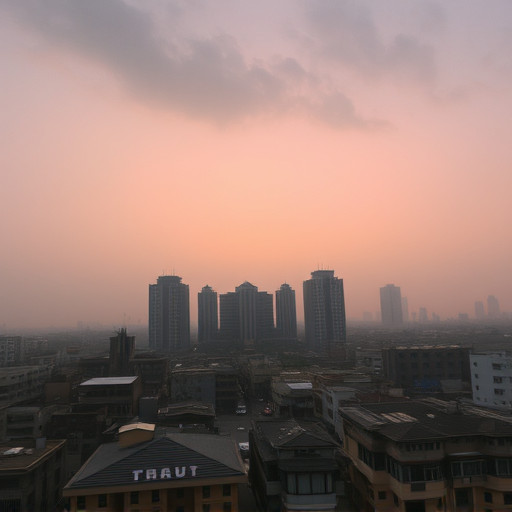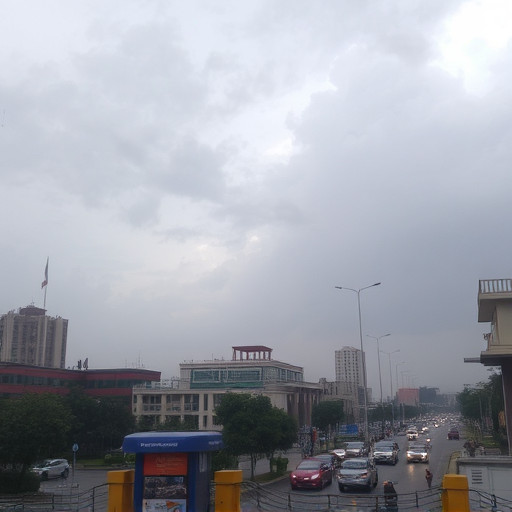
Karachi's wind patterns are influenced by its geographical setting, being hemmed in by the Kirthar Mountains and the Arabian Sea, which funnel air through a narrow passage, intensifying the local winds. The sea's large heat capacity creates distinct pressure systems that promote onshore winds along the coast, while the Indus River delta and surrounding islands affect local wind flow. These natural elements interplay with broader weather systems like monsoon depressions and westerly wind streams to create a consistently windy climate in Karachi. Seasonally, strong onshore winds are common during the monsoon season, while calm or variable conditions prevail in winter, influenced by a mix of westerly and northwesterly winds from Iran. Karachi's urban environment further complicates wind dynamics due to tall buildings, heat absorption from materials and activities, and the city's position within the Indus River valley, near the sea, and surrounded by coastal hills, leading to both predictable and unpredictable localized wind phenomena that influence its microclimate. Understanding these factors is crucial for urban planning, infrastructure development, and public safety in this Pakistani metropolis, as they significantly affect daily life, transportation, and building integrity. Additionally, the thermal dynamics of the Arabian Sea contribute to the generation of sea breezes, which are strongest during the summer when the temperature gradient between land and sea is most significant, complementing the influence of the southwest monsoon from June to September. These strong winds bring necessary rainfall but also pose challenges due to their potential for causing disruptions in the city.
Karachi, a bustling metropolis on the Arabian Sea, experiences consistent windiness that shapes its weather patterns. This article delves into the multifaceted influences contributing to Karachi’s frequent gusts, from geographic factors to seasonal variations, and the complex interplay of local urban dynamics and oceanic currents, particularly during monsoon seasons. Furthermore, the implications of climate change on the city’s wind dynamics are examined to understand the evolving weather trends. Join us as we explore the varied forces at play in making Karachi one of the windiest cities globally.
- Geographic Factors Contributing to Karachi's Windiness
- Seasonal Patterns Affecting Wind Speed in Karachi
- Localized Urban Effects on Wind Conditions
- Oceanic Influences and Monsoon Winds
- Climate Change and Its Impact on Karachi's Wind Dynamics
Geographic Factors Contributing to Karachi's Windiness

Karachi, situated on the Arabian Sea coast in Pakistan, experiences consistent winds due to its unique geographic location and surrounding topography. The city is enclosed by the Kirthar Mountains to the north and the Arabian Sea to the south, creating a topographical feature known as an “atmospheric bottleneck.” This phenomenon funnels air through a narrow passage, amplifying wind speeds as it flows into the region. Additionally, the sea’s large heat capacity moderates temperature extremes, leading to distinct pressure systems over land and sea that drive prevailing onshore winds along the coast. The shape of the land, including the Indus River delta and adjacent islands, further influences airflow patterns, contributing to the frequent and sometimes strong winds characteristic of Karachi’s climate. These geographic factors interplay with synoptic weather systems, such as monsoon depressions and westerly wind streams, to sustain the city’s windy conditions throughout much of the year.
Seasonal Patterns Affecting Wind Speed in Karachi

Seasonal patterns play a pivotal role in modulating wind speed conditions within Karachi, a coastal city located on the Arabian Sea in Pakistan. The monsoon season, which spans from June to September, is characterized by strong onshore winds brought by the southwest monsoon flowing from the Indian Ocean towards the Arabian Sea. These winds intensify as they are funneled through the Karachi Bay, often leading to gusty and sustained high wind speeds during this period. Conversely, during the winter months, from December to February, the prevailing westerly winds from the Iranian plateau converge with the northwesterly winds, creating a complex wind system that can result in variable and sometimes calm wind conditions over Karachi. Additionally, the topography of the region, including the Kirthar mountains to the northeast, influences the wind flow and can lead to localized changes in wind speed and direction. Understanding these seasonal variations is crucial for urban planning, infrastructure development, and ensuring public safety as high winds can impact daily life, transportation, and building stability in Karachi.
Localized Urban Effects on Wind Conditions

Karachi’s urban landscape presents a complex system where localized effects significantly influence wind conditions. The city’s expansive sprawl, punctuated by high-rise buildings and densely populated neighborhoods, alters airflow patterns. Heat absorption by construction materials and human activities such as traffic congestion and industrial operations contribute to local heating effects, which in turn create thermal lows and highs within the urban fabric. These temperature variations drive convective currents that can lead to gusty winds, particularly during the afternoon when solar radiation is at its peak.
Furthermore, Karachi’s topography interacts with the wind, as the Indus River valley, coastal hills, and the Arabian Sea influence the wind patterns around the city. The city’s geographical setting, with its proximity to the sea and the presence of natural barriers like hills, can lead to complex atmospheric dynamics. The interaction between these physical features and the prevailing monsoon winds results in localized wind phenomena that can be both predictable and unpredictable, affecting microclimates within the city and contributing to its reputation for being particularly windy during certain times of the year. These localized urban effects on wind conditions are critical factors that must be considered when understanding the broader meteorological aspects of Karachi’s climate.
Oceanic Influences and Monsoon Winds

Karachi, a coastal city in Pakistan, is frequently subject to windy conditions influenced by both the Arabian Sea and seasonal monsoon winds. The proximity of the city to the ocean plays a significant role in its weather patterns. The vast expanse of water has its own thermal dynamics; during the day, the sea heats up more slowly than the land, which can lead to the formation of sea breeze. As the air over the land warms and rises, it is replaced by cooler, denser marine air moving inland, often resulting in strong onshore winds. This phenomenon is particularly pronounced during the summer months when the temperature gradient between land and sea is greatest.
Furthermore, the monsoon winds, a seasonal feature, have a profound impact on Karachi’s windiness. The southwest monsoon, which affects South Asia from June to September, brings heavy rains and strong winds to the region. These winds originate over the warm Indian Ocean and flow towards the cooler Arabian Sea. As they encounter the landmass of Pakistan, they can be channeled through the Indus valley, amplifying their speed and intensity. The topography of the region, with its long coastline and the presence of the Kirthar mountain range, can further influence the monsoon winds, leading to gusty conditions that are a common occurrence in Karachi during this period. These winds not only bring much-needed rain but also contribute to the high wind speeds experienced in the city, often necessitating caution for residents and visitors alike.
Climate Change and Its Impact on Karachi's Wind Dynamics

Climate change has profound implications for wind dynamics in Karachi, a coastal metropolis situated along the Arabian Sea in Pakistan. The rising global temperatures associated with climate change are influencing atmospheric circulation patterns, which can alter the prevailing wind directions and intensities. The warming of land and sea surfaces alters thermal gradients, leading to shifts in pressure systems that can enhance or diminish wind speeds over the region. Additionally, changes in the jet stream’s path due to global warming may also influence the monsoon winds affecting Karachi, potentially exacerbating the frequency and intensity of high-wind events. These shifts can result in more frequent or severe weather phenomena, including sandstorms and strong coastal winds that affect the city’s residents. The modification of wind patterns not only has implications for local climate but also poses challenges for infrastructure, agriculture, and the overall ecological balance of the region.
Furthermore, the urbanization of Karachi has altered its topographical features and the heat island effect exacerbates local warming. This anthropogenic impact contributes to the dynamics of wind formation and distribution within the city. The expansion of concrete surfaces reduces natural vegetation cover, which traditionally played a role in modifying wind speeds and trajectories. The interaction between these human-induced changes and the broader climatic variations due to global warming underscores the complexity of predicting future wind conditions in Karachi. It is imperative for city planners and environmental scientists to monitor and understand these shifts to develop strategies that mitigate potential risks associated with altered wind dynamics.
Karachi’s windy conditions are a complex interplay of geographic, seasonal, urban, and oceanic factors. The city’s topography, proximity to the Arabian Sea, and local climate patterns all contribute to its frequent gusts. As seasons shift, so do the prevailing winds, with particularly high speeds observed during specific times of the year. Urban development further influences wind behavior within the city. Additionally, the effects of climate change are becoming increasingly evident, altering historical wind dynamics and potentially exacerbating wind conditions. Understanding these interrelated factors is crucial for urban planning and for developing strategies to mitigate the challenges posed by Karachi’s windy environment.


